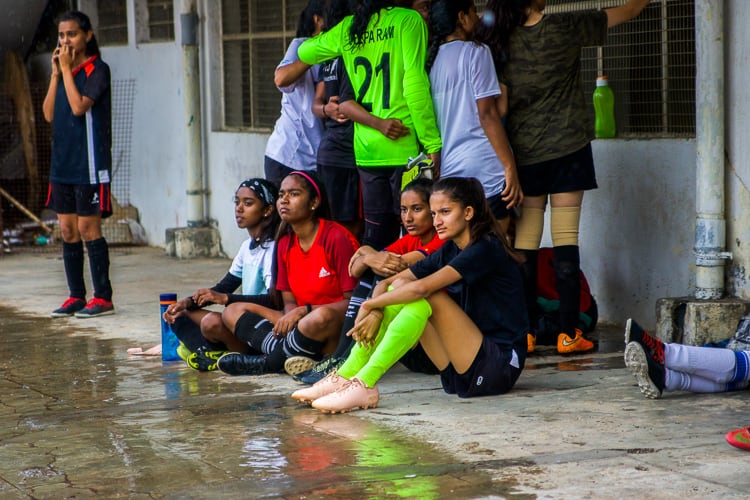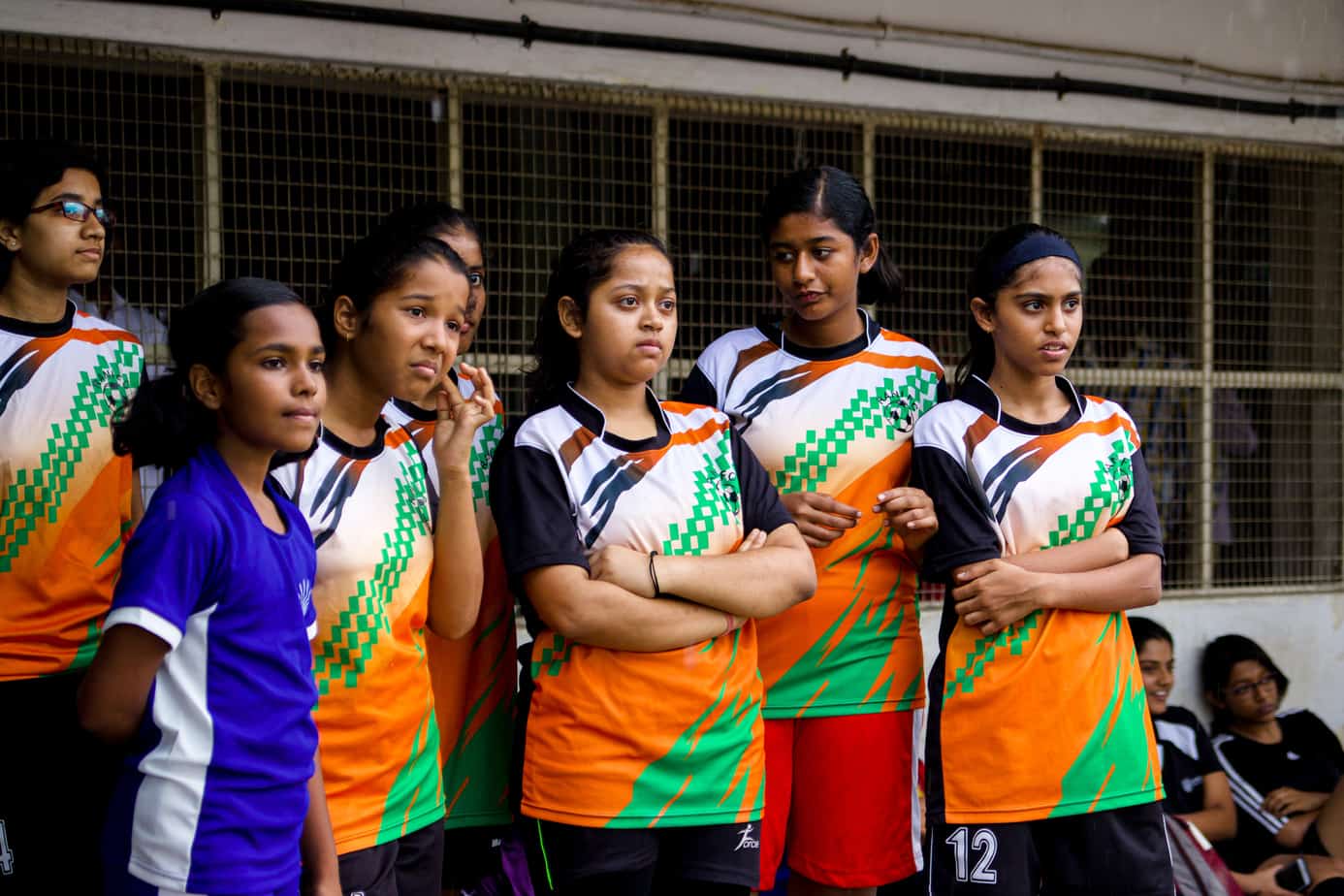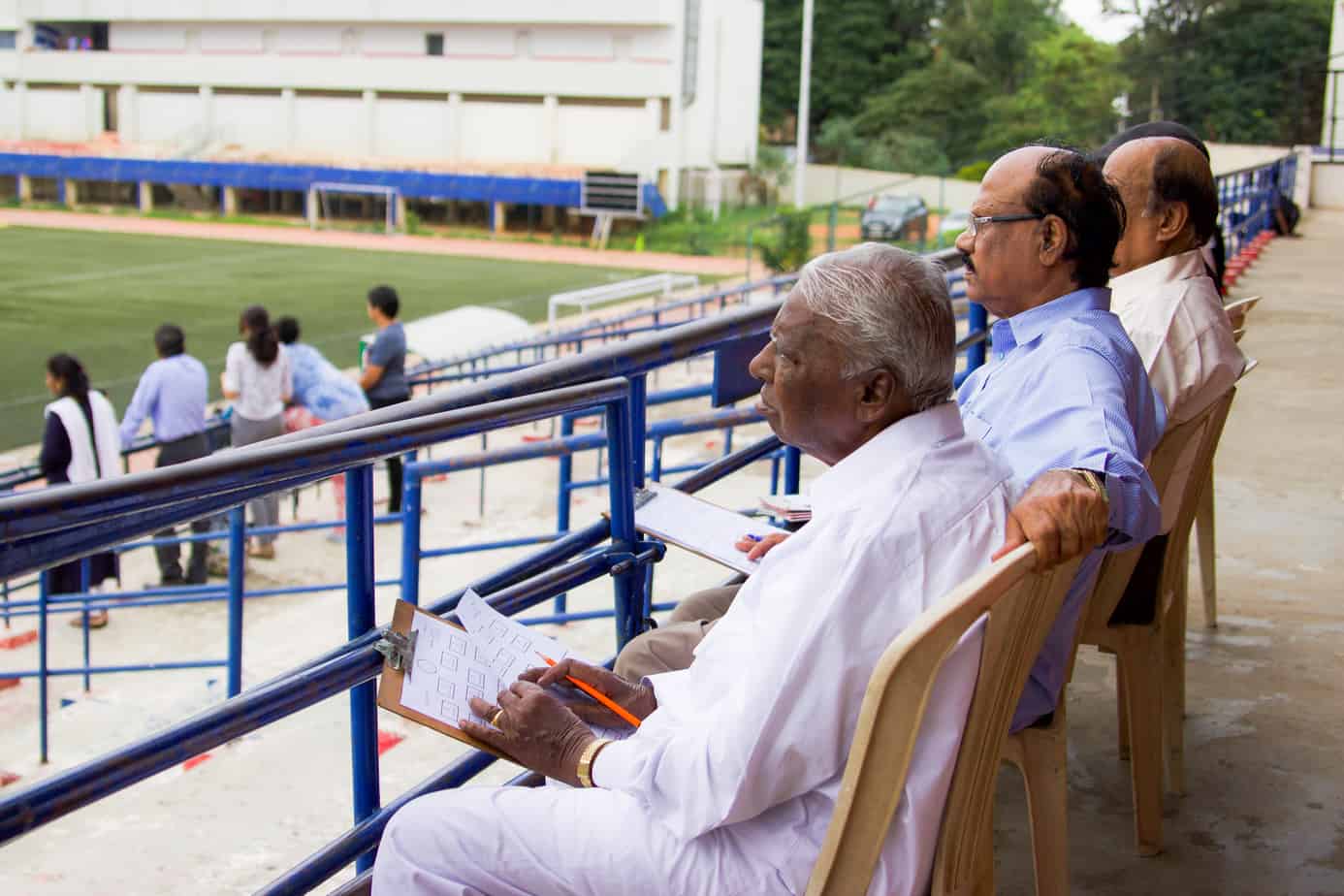
A group of girls await their turn at the Karnataka state women’s team trials. Pic: ‘DD’ Grace Madigan
Over 100 girls descended upon Bangalore Football Stadium on a July evening for their chance to make the Karnataka state women’s team. Twenty two of them took the field in a scrimmage, in hopes of impressing the scouts and earning a spot on the roster.
Others sat in the stands, taking off shin guards and cleats, sweat dripping from having just played. Some others wait down by the field for their turn. A few huddle in small groups, laughing and taking pictures, while others sit alone, stoically watching the game. All of them there for one reason – their love of football.
Shreya G Kashyap is one of these girls. Some of her teammates from her school team are with her. Their nerves are abated by the biscuits they munch on, and a visit from a stray dog before their game.
Shreya’s parents explain that her school team doesn’t get much training or attention from the school’s sports coach, who also is in charge of the boys.

Shreya G Kashyap (second from right) and her teammates watch trials before it’s their turn to take the field. Pic: ‘DD’ Grace Madigan
This story isn’t unusual—the lack of support for girls’ football is a symptom of the patriarchal ideas leftover from decades past, that this nation still wrestles with. The idea that girls can’t or shouldn’t play football continues to be an obstacle to the sport’s growth in the country. While this idea is slowly being chipped away at, the effects of not having the early onset infrastructure and support to grow the girl’s game has meant that India has fallen behind its Asian counterparts and the rest of the world.
National team recovering after decades
Women’s football didn’t exist in India – at least not in any official capacity – until the creation of the Women’s Football Federation of India (WFFI) in 1975. From then to the early 1990s, WFFI administered women’s football matches in the country.
Chitra Gangadharan is a former footballer from Karnataka, and currently a coach for Bangalore United Football Club. She had captained the Indian national team from 1977 to 1978. She was also on the team when it placed second and third at the AFC Women’s Asian Cup in 1979 and 1981 respectively. The AFC Cup is the biggest football tournament in Asia, and now serves as qualifying tournament for the women’s World Cup.
Despite the early success, the national team’s performance and women’s football in India faltered. The WFFI merged with the All India Football Federation (AIFF) in the 1990s, and a period of reorganising followed. The transfer of responsibility of women’s football to AIFF, combined with several national players leaving the team for varying reasons, marked a period of struggle, says Chitra. Since then the national team did win some games, but didn’t see any top finishes as in the 80s.
The team hit a new low in 2009, when FIFA delisted it from the world rankings due to lack of activity for 18 months. But efforts are on now, to make Indian women’s football more than just a footnote in the game’s history.
After the FIFA delisting, the women’s national team went on several exposure trips, playing in tournaments such as the AFC Olympic Qualifiers Round 2, the SAFF Championships, and the COTIF Cup in which they finished third. They also participated in exhibition matches (which are for practice, and aren’t part of tournaments) in Hong Kong, Indonesia and Turkey.
The team gradually built on small successes, and has climbed the FIFA ranks. This July, its ranking climbed up six places to number 57 in the world – just six spots behind Jamaica who participated in the World Cup this year.
A long-term plan to grow the game
Back in 2016, with the support of FIFA, AIFF launched the Indian Women’s League (IWL) – similar to the mens’ football league ISL (Indian Super League) – as part of a long-term plan to grow the women’s game. The idea was to give women footballers the opportunity to play regularly, rather than just the occasional tournament. As the IWL was launched, prominent football clubs started making women’s teams. “Once the clubs started making teams, there was more demand for the girls,” Chitra says.
At the IWL’s inaugural season in October 2016, only six teams participated. Now the number has grown to 12. Recently, the AIFF announced plans to have 24 teams, with 18 matches for each team, from next year. The three previous IWL seasons had lasted only 2-3 weeks.
Karnataka’s first women’s league
Last year, AIFF sent out a mandate to states to set up their own women’s leagues as well. In each state league, teams from clubs across the state would compete. The winning team from each state league will then get to play in the IWL.
Never before in its 72-year existence did the Karnataka State Football Association (KSFA) have a women’s league. This changed last year, on the initiative of former footballer and journalist M Satyanarayan, who was then a member of the Governing Board and Core Committee of the KSFA. Last December, Satyanarayan and KSFA President N A Haris met the AIFF to discuss the possibility of starting a women’s league in Karnataka.
KSFA’s support for women’s football came in part because of the Impetus Tournament held for the first time in August last year. To gauge the state of women’s football in Karnataka, Satyanarayan had organised this 11-a-side tournament at the Bangalore Football Stadium. He was told that only four teams would play at the most.
“I just issued a press release to newspapers – a small one saying we wanted to start a women’s tournament, and all the clubs, institutions, teams that are interested could take part,” Satyanarayan says. “And you won’t believe it, 18 teams took part.”
On realising there was so much interest in the women’s game, KSFA created its state league – the Super Division League – in January. Five teams participated in the league’s matches this year, and the winning team Bangalore United FC was sent to play in the IWL.
Satyanarayan, who is now the General Secretary of KSFA, hopes to eventually create a committee for women’s football there, that he can oversee and help direct. Currently it’s just him as the ‘women’s commissioner for football’ at the association.

Scouts at phase 1 of the trials to the Karnataka state team. Phase 1 was open to girls who’d never played for the state or a Super Division before. Pic: ‘DD’ Grace Madigan
“Suddenly, we realised that a lot of girls were playing football, but they were not in clubs. You know, they were not in any school or college teams, but they had been playing football,” Satyanarayan says. In July, KSFA started a campaign named ‘No Girl Left Behind’, to create a database of all girls playing in the state. They ended up collecting information of over 300 girls, including their age and whether they played for a club.
KSFA then created a WhatsApp group of these players, where it would announce information on trials, events and news pertaining to women’s football. The association’s open trials for the state team in July was also broadcasted in this group.
Satyanarayan is now spearheading another major addition for KSFA. The association will likely have an A-Division next season, which will be a tier below the Super Division League.
Twenty teams have expressed interest, and intend to vie for a spot in the proposed A-division. Some of them are newly-created clubs while others are more established ones like Shining Stars FC and Bangalore United FC. The idea of the A-Division – KSFA hesitates to call it a league as they don’t know if it will be structured as such – is to give 120 new players opportunities to play in organised matches on teams.
“We come from an association where we haven’t done much for women’s football, so now we are coming forward. We want our girls to play,” Satyanarayan simply puts.
[Part 3 of this series tells the stories of underprivileged girls whose lives are being transformed by football, and of women who are picking up the game at a later age]